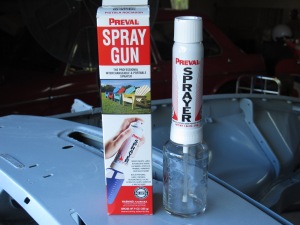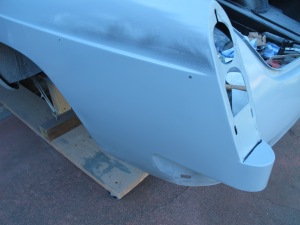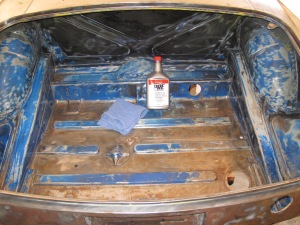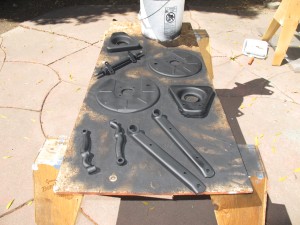I picked up a 1994 3.4L engine from GM Sports in San Jose yesterday. It came complete with everything, including fuel injection, the wiring harness, the ECU, power steering pump, air conditioner pump, starter, and alternator. In addition,  I purchased a five-speed T5 gearbox, which came with the clutch, flywheel, shifter, bell housing, and slave cylinder. Also included was the driveshaft and cross member, which I won’t need.
I purchased a five-speed T5 gearbox, which came with the clutch, flywheel, shifter, bell housing, and slave cylinder. Also included was the driveshaft and cross member, which I won’t need.
The first challenge of the day was to get the thing out of the back of my Element without killing myself. The cherrypicker came in handy for that. I just lifted enough to take the weight off then drove the car  forward until it was clear.
forward until it was clear.
My first impression was that the lump was too large to fit in the MGB. It looked HUGE with all of the auxiliary parts attached. My second impression is that the fuel injection looks WAY too complicated. I’ve done a lot of research on engine management and fuel injection but I am leaning towards a carburetor  at this point. While there is no doubt that fuel injection is a better fuel delivery system, I nevertheless prefer the simplicity of a carburetor. Plus I want the engine to look like it belongs in the car and fuel injection is a dead giveaway. I like modified cars that look like they came from the factory that way. If an average person can point out the mods, they were not well planned in my opinion; you might as well get huge spinning chrome wheels and go on Pimp my Ride.
at this point. While there is no doubt that fuel injection is a better fuel delivery system, I nevertheless prefer the simplicity of a carburetor. Plus I want the engine to look like it belongs in the car and fuel injection is a dead giveaway. I like modified cars that look like they came from the factory that way. If an average person can point out the mods, they were not well planned in my opinion; you might as well get huge spinning chrome wheels and go on Pimp my Ride.
After stripping all of the auxiliary components from the power unit, it  actually began to look like a V6 engine again. Converting to a carburetor will require obtaining an Edelbrock manifold base, a modified (shortened) manifold adapter, a Chevy S10 distributor unit, and a suitable carb. In addition, a cam swap may be required. GM parts are, however, much more reasonably priced than their MG counterpart and available at my local auto parts store.
actually began to look like a V6 engine again. Converting to a carburetor will require obtaining an Edelbrock manifold base, a modified (shortened) manifold adapter, a Chevy S10 distributor unit, and a suitable carb. In addition, a cam swap may be required. GM parts are, however, much more reasonably priced than their MG counterpart and available at my local auto parts store.

















































